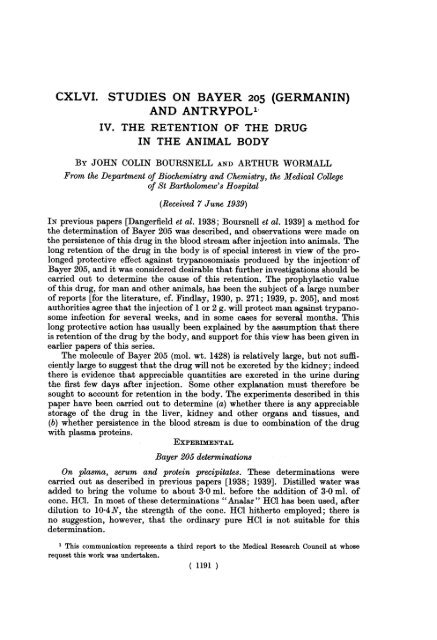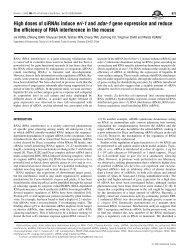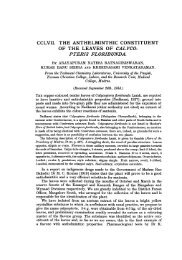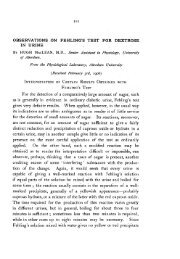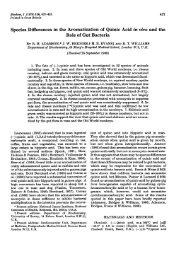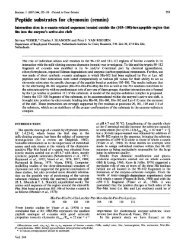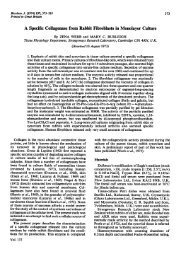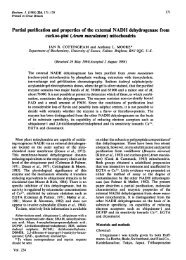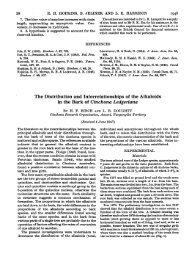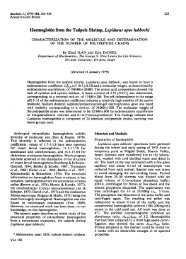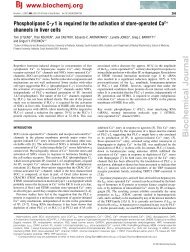CXLVI. STUDIES ON BAYER 205 (GERMANIN) AND ANTRYPOL1
CXLVI. STUDIES ON BAYER 205 (GERMANIN) AND ANTRYPOL1
CXLVI. STUDIES ON BAYER 205 (GERMANIN) AND ANTRYPOL1
You also want an ePaper? Increase the reach of your titles
YUMPU automatically turns print PDFs into web optimized ePapers that Google loves.
<strong>CXLVI</strong>. <strong>STUDIES</strong> <strong>ON</strong> <strong>BAYER</strong> <strong>205</strong> (<strong>GERMANIN</strong>)<br />
<strong>AND</strong> <strong>ANTRYPOL1</strong><br />
IV. THE RETENTI<strong>ON</strong> OF THE DRUG<br />
IN THE ANIMAL BODY<br />
BY JOHN COLIN BOURSNELL <strong>AND</strong> ARTHUR WORMALL<br />
From the Department of Biochemistry and Chemistry, the Medical College<br />
of St Bartholomew's Hospital<br />
(Received 7 June 1939)<br />
IN previous papers [Dangerfield et al. 1938; Boursnell et al. 1939] a method for<br />
the determination of Bayer <strong>205</strong> was described, and observations were made on<br />
the persistence of this drug in the blood stream after injection into animals. The<br />
long retention of the drug in the body is of special interest in view of the prolonged<br />
protective effect against trypanosomiasis produced by the injection' of<br />
Bayer <strong>205</strong>, and it was considered desirable that further investigations should be<br />
carried out to determine the cause of this retention. The prophylactic value<br />
of this drug, for man and other animals, has been the subject of a large number<br />
of reports [for the literature, cf. Findlay, 1930, p. 271; 1939, p. <strong>205</strong>], and most<br />
authorities agree that the injection of 1 or 2 g. will protect man against trypanosome<br />
infection for several weeks, and in some cases for several months. This<br />
long protective action has usually been explained by the assumption that there<br />
is retention of the drug by the body, and support for this view has been given in<br />
earlier papers of this series.<br />
The molecule of Bayer <strong>205</strong> (mol. wt. 1428) is relatively large, but not sufficiently<br />
large to suggest that the drug will not be excreted by the kidney; indeed<br />
there is evidence that appreciable quantities are excreted in the urine during<br />
the first few days after injection. Some other explanation must therefore be<br />
sought to account for retention in the body. The experiments described in this<br />
paper have been carried out to determine (a) whether there is any appreciable<br />
storage of the drug in the liver, kidney and other organs and tissues, and<br />
(b) whether persistence in the blood stream is due to combination of the drug<br />
with plasma proteins.<br />
EXPERIMENTAL<br />
Bayer <strong>205</strong> determinations<br />
On plasma, serum and protein precipitates. These determinations were<br />
carried out as described in previous papers [1938; 1939]. Distilled water was<br />
added to bring the volume to about 3 0 ml. before the addition of 3 0 ml. of<br />
conc. HCI. In most of these determinations "Analar " HCI has been used, after<br />
dilution to 104N, the strength of the conc. HCl hitherto employed; there is<br />
no suggestion, however, that the ordinary pure HCI is not suitable for this<br />
determination.<br />
1 This communication represents a third report to the Medical Research Council at whose<br />
request this work was undertaken.<br />
( 1191
1192<br />
J. C. BOURSNELL <strong>AND</strong> A. WORMALL<br />
All the measurements were made with the Lovibond tintometer discs<br />
previously described. Compensation for the small blank value for normal plasma<br />
or serum (equivalent to about 1.0 mg. Bayer <strong>205</strong>/100 ml.) was effected by a<br />
control tube containing a corresponding amount of hydrolysed, diazotized and<br />
coupled normal plasma, serum or plasma-protein. The hydrolyses or diazotizations<br />
were usually carried out in duplicate and these almost invariably showed<br />
satisfactory agreement. The results recorded in the tables are average values<br />
for two or more determinations, and have been corrected, unless otherwise<br />
stated, for the blank values for normal serum, plasma etc.<br />
On tissUes. As soon as each rabbit was killed, various organs were removed,'<br />
dried on filter paper and weighed. Weighed amounts of the tissues (usually<br />
1-5-2-5 g. except where the amount available was small) were quickly transferred<br />
to stoppered pyrex tubes graduated at 10 ml. Water was added to give<br />
a volume of about 3 ml., and 3 ml. of 10*4N HC1 were added at once to prevent<br />
bacterial or enzymic changes in the tissue. After hydrolysis many of these<br />
solutions had a very dark colour which was not completely removed by treatment<br />
with kaolin. To compensate for this colour, a control mixture was prepared<br />
for each hydrolysate, containing all the reagents used for the colorimetric<br />
determination except sodium nitrite, and when this control solution was placed<br />
in the appropriate part of the comparator, satisfactory matching of the colours<br />
could be made. For several reasons it was not possible to compensate for the<br />
blank values of normal tissues by the simple procedure used with plasma or<br />
serum, and it was necessary to carry out determinations on the tissues of<br />
normal rabbits kept under the same conditions as the injected animals. The<br />
results recorded in Tables I and II represent, therefore, values for Bayer <strong>205</strong><br />
plus other " amine-precursors ", but the values for normal tissues are sufficiently<br />
constant (cf. Table I) to justify the subtraction of "blanks" for each tissue, to<br />
give values which represent the Bayer <strong>205</strong> content of the tissues of the injected<br />
rabbits (Fig. 1). The source of these amines present in hydrolysed normal tissues<br />
has not been investigated, but it is probable that they originate mainly from<br />
protein, as they do in the case of normal plasma. The recovery of Bayer <strong>205</strong><br />
added to various normal tissues is not as good as the recovery from plasma, but<br />
it is sufficiently satisfactory for the purposes of this investigation. Amounts of<br />
Bayer <strong>205</strong> equal to those found in the tissues of the injected rabbits are recovered<br />
to the extent of 80-90% with most tissues (kidney, heart, brain etc.), but the<br />
recovery with liver tissue is only 55-65 %.<br />
In these experiments on "storage" in the tissues, and in many others,<br />
Antrypol has been used, and in this work the two terms (Antrypol and Bayer<br />
<strong>205</strong>) are used synonymously.<br />
The Antrypol content of varioUs organs and tissues following the injection<br />
of the drug into rabbits<br />
Three groups of rabbits received intravenous injections of Antrypol solutions<br />
at intervals; at each injection 0*03 g. Antrypol/kg. was given. The injections<br />
were made at intervals of 3 weeks, and two groups were killed 3 weeks after<br />
they had received the last injection. The third group, that receiving three injections,<br />
was left for 10 weeks after the last injection, since it was thought<br />
advisable to avoid a high plasma-Bayer <strong>205</strong> level which would cause high values<br />
1 The authors would like to take this opportunity of thanking Dr J. L. D'Silva of the Department<br />
of Physiology for his generous assistance with these operations.
METABOLISM OF <strong>BAYER</strong> <strong>205</strong> 1193<br />
to be obtained for tissues rich in blood. The weights of the rabbits ranged from<br />
1-7 to 3*1 kg. The details of the injections can be tabulated as follows:<br />
Interval<br />
Intervals<br />
between<br />
between last<br />
injection<br />
No. of No. of injections and death<br />
rabbits injections days days<br />
Group A 3 1 21<br />
Group B 3 2 21 21<br />
Group C 4 3 21 and 21 70<br />
Two control rabbits for each group were kept under similar conditions with<br />
regard to diet etc., and were subsequently treated in the same way as the<br />
injected animals. The results of this experiment are given in Tables I and II<br />
and in Fig. 1. With the injected rabbits, as with the controls, there is good<br />
agreement between two samples of the same organ, although these samples<br />
were often taken, from different parts of the organ concerned. If the values for<br />
the kidney are excluded, the average difference between duplicates of this type<br />
is less than 004 mg./g. of tissue.<br />
The "true " Antrypol values for the organs of the injected rabbits are plotted<br />
in Fig. 1. These figures represent the differences between the averages for each<br />
organ of each group of injected rabbits and the corresponding average "blank"<br />
values for the control animals (last column, Table I). The results obtained show<br />
that there is a small amount of the drug in each of the organs examined, with<br />
the possible exception of the brain. Part of the Antrypol present in each tissue<br />
can certainly be attributed to the blood and tissue fluid of that organ, but there<br />
is usually sufficient to indicate a slight retention of the drug in the tissues in<br />
addition to that present in the blood. It is suggested that this retention is due<br />
to combination with tissue proteins, but with two exceptions the amount of<br />
drug retained in any one organ is very small. The values for the kidney, however,<br />
are considerably higher than those for any other organ or that for plasma, and in<br />
addition there is distinct variation between the values for different rabbits of<br />
the same group (cf. Table II). The spleen also gives higher results than those for<br />
Table I. Amines produced by acid hydrolysis of tissues of normal rabbits<br />
Calculated as mg. Bayer <strong>205</strong>/g. tissue or/ml. of plasma<br />
No. 170 No. 177 No. 185 No. 188 No. 297 No. 299 Average<br />
Kidney 0 070<br />
0-031<br />
0 033<br />
0-029<br />
0-048<br />
0-052<br />
0-042<br />
0-043<br />
0 039<br />
0*039<br />
0-041<br />
0 044<br />
0.043<br />
Liver 0039<br />
0-041<br />
0-042<br />
0-046<br />
0 050<br />
0 050<br />
0035<br />
0*039<br />
0-032<br />
0.034<br />
0-038<br />
0-036<br />
0-040<br />
Heart 0 033<br />
0.034<br />
0 033<br />
0 033<br />
0 055<br />
0 039<br />
0 037<br />
0-038<br />
0 047<br />
0-047<br />
0-048<br />
0*040<br />
0 040<br />
Muscle* 0-022 0.030 0-034 0-024 0 035 0-016 0-026<br />
- 0-023 0-027 0-032 0-015<br />
Lung 0-048 0-032 0 035 0.034 0.036 0-042 0 039<br />
0 050 0 035 0-041 0-036 0 039<br />
Brain 0-036 0-022 0-029 0-028 0-028 0-025 0-028<br />
0-028 0.034 0-026 0-027 - 0-026<br />
Adrenals 0 033 0-029 0-012 0.034 0-016 0.015 0-023<br />
Spleen 0 054 0-063 0-061 0-069 0-042 0 070 0-060<br />
Pancreas 0-031 0-016 0-024 0-029 0-030 0-032 0-027<br />
Plasma 0-008 0-008 0-008 0-008 0-008 0 007 0-008<br />
* From the abdominal wall.
1194<br />
J. C. BOURSNELL <strong>AND</strong> A. WORMALL<br />
Table II. Tissues of rabbits injected with Antrypol (Antrypol plus other<br />
amine-precursors in terms of mg. Bayer <strong>205</strong>/g. tissue or/ml. of plasma)<br />
_<br />
244<br />
Kidney 0-239<br />
0-210<br />
Liver 0-059<br />
0-047<br />
Heart 0-062<br />
0 059<br />
Muscle 0 035<br />
Lung 0-060<br />
0-065<br />
Brain 0-029<br />
0-029<br />
Adrenals 0 035<br />
Spleen 0-129<br />
Pancreas 0 034<br />
Plasma 0 040<br />
Group A<br />
(1 injection)<br />
Rabbit no.<br />
A<br />
282<br />
0*139<br />
0-069<br />
0*068<br />
0*066<br />
0-068<br />
0-052<br />
0-056<br />
0-056<br />
0-029<br />
0*032<br />
0 047<br />
0-107<br />
0*043<br />
0037<br />
283<br />
0-111<br />
0*114<br />
0 049<br />
0*047<br />
0-058<br />
0 053<br />
0-043<br />
0 040<br />
0*053<br />
0 050<br />
0*026<br />
0*029<br />
0*047<br />
0*089<br />
0*034<br />
0-031<br />
Group B<br />
(2 injections)<br />
Rabbit no.<br />
229 237 241<br />
0-111<br />
0-122<br />
0-290<br />
0-310<br />
0-124<br />
0*103<br />
0-064<br />
0*056<br />
0-067<br />
0-063<br />
0-060<br />
0 055<br />
0-061<br />
0 073<br />
0-063<br />
0-064<br />
0-062<br />
0-062<br />
0 061<br />
-<br />
0*058<br />
0046<br />
0-053<br />
0-047<br />
0-071 0-068 0-072<br />
0-071 0*061 0*068<br />
0*034 0-027 0-027<br />
0-032 0*032 0*029<br />
0*072 0*063 0 054<br />
0*155 0*091 0-114<br />
0*059 0*045 0-046<br />
0-056 0-048 0-049<br />
285<br />
0-104<br />
0-105<br />
0-038<br />
0-041<br />
0 054<br />
0*049<br />
0-018<br />
0-026<br />
0*040<br />
0-044<br />
0*026<br />
0-026<br />
0-026<br />
0 073<br />
0 034<br />
0*020<br />
Group C<br />
(3 injections)<br />
Rabbit no.<br />
289<br />
0-119<br />
0-116<br />
0*055<br />
0-056<br />
0*062<br />
0-064<br />
0030<br />
0*051<br />
0-049<br />
0-031<br />
0-027<br />
0 030<br />
0-115<br />
0-041<br />
0-020<br />
301<br />
0*099<br />
0-102<br />
0 044<br />
0*041<br />
0*047<br />
0 049<br />
0-014<br />
0-017<br />
0*050<br />
0 050<br />
0-027<br />
0*028<br />
0*029<br />
0-123<br />
0 034<br />
0-019<br />
317<br />
0*116<br />
0-123<br />
0-057<br />
0-058<br />
0-057<br />
0 049<br />
0-017<br />
0-024<br />
0055<br />
0 055<br />
0-024<br />
0-025<br />
0 073<br />
0-167<br />
0*033<br />
0-022<br />
3a a OS X XSX4<br />
uUzU<br />
".4<br />
0<br />
t<br />
0-IS<br />
ez 0-05<br />
F-i--<br />
5.4<br />
0-15<br />
0-10<br />
005<br />
Fig. 1. The Antrypol content of the tissues of rabbits which had received injections of the drug.<br />
plasma, but not as high as those for the kidney. In the case of two of the<br />
rabbits, determinations were also carried out with bone marrow and a portion of<br />
small intestine; values similar to those for heart, liver, muscle etc. were obtained.<br />
The combination of Bayer <strong>205</strong> with plama proteins<br />
For this investigation several methods have been used. In some experiments<br />
Bayer <strong>205</strong> has been added to serum (rabbit and horse), and in others blood was<br />
taken from rabbits which had previously received injections of the drug. The
METABOLISM OF <strong>BAYER</strong> <strong>205</strong><br />
plasma and serum proteins were then separated by various methods and the<br />
amount of Bayer <strong>205</strong> in each fraction was determined. In many of the experiments<br />
no attempt was made to find the relative combining capacities of the<br />
different proteins for Bayer <strong>205</strong>, the main object being to determine whether<br />
the drug can combine with plasma proteins. In view of the anticoagulant<br />
action of this compound, however, particular attention has been paid to the<br />
fibrinogen fraction.<br />
(a) Bayer <strong>205</strong> added to serum. Normal horse serum was treated with 0 04 vol.<br />
of a strong Bayer <strong>205</strong> solution and kept at room temperature for 1 hr.; the<br />
globulins were then separated from portions of this mixture by C02. The results<br />
recorded in Table III indicate that a considerable amount of the added drug<br />
attaches itself to the globulins. Washing with water saturated with C02, or<br />
reprecipitation with C02, removes part only of the "attached" drug, and the<br />
observed loss is largely due in the first case to solution of the globulin-drug<br />
complex, and in the second to the difficulty in effecting complete reprecipitation<br />
of the globulin.<br />
Table III. Separation of the globulins fromn serum to which Bayer <strong>205</strong><br />
has been added<br />
mg. Bayer <strong>205</strong>/100 ml. serum*<br />
1195<br />
Whole serum (horse) 93 1X7 48 97<br />
Globulin fraction (CO2) 53 1X2 17 26<br />
Globulin fraction (washed) 46 1-2 17 22<br />
Globulin fraction (reprecipitated) 35 1V2 13 21<br />
Experimental details. A mixture of 1 vol. of serum and 9 vol. of distilled water was cooled in<br />
ice-water, and the globulins were precipitated by passing in CO to give maximum precipitation.<br />
The mixture was kept in ice-water for 20 min. and centrifuged. The deposit was dissolved in 1 vol.<br />
of 0-9 % NaCl with the aid of sufficient dilute NaOH to give pH 7-5.<br />
Some of the globulin precipitates were washed with CO-saturated distilled water, and in other<br />
cases reprecipitation was effected by dilution and treatment with C02.<br />
* In these experiments and those recorded in Tables IV-VI, blank determinations have been<br />
made on the corresponding fractions of normal plasma or serum, and compensation has been<br />
made for the small amount of amine-precursors present in some of these controls.<br />
In other experiments the drug was added to horse (and rabbit) serum and<br />
the proteins precipitated by alcohol. Precipitation was effected by adding 3 vol.<br />
of absolute alcohol, and the precipitates were washed with absolute alcohol<br />
(4 vol.) and finally with ether (4 vol.). With greatly varying amounts of Bayer <strong>205</strong><br />
(1-90 mg./100 ml.) the protein precipitates contained almost all (93-95 %) of the<br />
added drug.<br />
(b) The plmma of rabbits injected with Bayer <strong>205</strong>. Blood was taken from<br />
rabbits which had previously received one or more intravenous injections of<br />
Bayer <strong>205</strong>, the conditions of the experiment being varied as much as possible to<br />
obtain a wide range of plasma-Bayer <strong>205</strong> values.<br />
Precipitation of the plasma proteins by alcohol gave preparations which<br />
contained 95-100% of the plasma-Bayer <strong>205</strong>. This combined or adsorbed<br />
Bayer <strong>205</strong> was not removed to any marked extent by washing with alcohol, and<br />
less than one-third was removed when the precipitates were washed with aqueous<br />
alcohol (Table IV).<br />
In other experiments various protein fractions (fibrinogen, fibrinogen plus<br />
globulin, and globulin) have been separated from Bayer <strong>205</strong>-containing blood<br />
from injected rabbits. The results recorded in Table V show that an appreciable
1196 J. C. BOURSNELL <strong>AND</strong> A. WORMALL<br />
Table IV.<br />
Bayer <strong>205</strong> content of alcohol-precipitated proteins of the plasma<br />
of rabbits which had received injections of the drug<br />
mg. Bayer <strong>205</strong>/100 ml. plasma<br />
Plasma 2-9 1-7 10-3 12-8 7-75 6-8 50 4-75 3-75<br />
Precipitated proteins:<br />
(a) 2-85 1-55 9-7 12-6 7-8 6-6 - -<br />
(b) - - 91 119 - 6*5 4-8 4-55 3-65<br />
(c) - - 3-45 3-25 2-85<br />
Experimental details. 2 ml. oxalated plasma were treated with 6 ml. of absolute alcohol, mixed<br />
well and centrifuged. Some of these precipitates were treated as follows:<br />
(a) Dried in vacuo over CaCl2.<br />
(b) Washed with 8 ml. of absolute alcohol, then with 8 ml. of ether and dried at room temperature.<br />
(c) Washed successively with 8 ml. of " 75 % alcohol" (1 vol. of water plus 3 vol. of alcohol),<br />
8 ml. of absolute alcohol and 8 ml. of ether; dried at room temperature.<br />
part, but not the whole, of the drug present in the plasma is attached to the<br />
globulin. Of the other plasma proteins the most interesting in this connexion is<br />
fibrinogen, since it has been suggested that the anticoagulant action of Bayer <strong>205</strong><br />
is due to the combination of the drug with fibrinogen. It has previously been<br />
noted, however, that plasma and serum obtained from the same blood contain<br />
the same amount of Bayer <strong>205</strong> [Boursnell et al. 1939], and further determinations<br />
covering a much wider range of Bayer <strong>205</strong> levels, and with considerable variation<br />
in the number of injections have fully confirmed this observation (cf. Table VI).<br />
From these results and from determinations on fibrinogen (fibrin) precipitated<br />
by the addition of CaCl2 to the diluted plasma (Table V), it is concluded that<br />
under the conditions of these experiments no significant part of the plasma-<br />
Bayer <strong>205</strong> is closely attached to the fibrinogen. The small amount present in the<br />
precipitated fibrin may possibly be associated with some component of fibrin<br />
other than fibrinogen.<br />
Table V. Bayer <strong>205</strong> content of separated proteins of the plasmas of injected rabbits<br />
mg. Bayer <strong>205</strong>/100 ml.<br />
Serum - 5.0 3.9<br />
Plasma 2 9 1-7 18 2 22 2 15 2 12-2<br />
Fibrinogen (fibrin) 0 3 0 3 1 0 0o9 0 8 0-3<br />
Fibrinogen plus globulin 1-0 0-75 - 2-85 2-6 3-0 1-7<br />
Globulin - - 1.5 0-95<br />
Experimental detail8. Fibrinogen (fibrin) was separated by the addition of CaCl2 to plasma<br />
diluted with 0 85% NaCl, and fibrinogen plus globulin by the addition to plasma of 19 vol. of<br />
27*79 % (NH4)2S04 solution [for full details, cf. Harrison, 1937]. Serum globulin was separated by<br />
the addition of 1 vol. of water and 2 vol. of saturated (NH4)2S04 solution, and the precipitate was<br />
washed with about 3 vol. of half-saturated (NH4)AS04 solution.<br />
Table VI.<br />
Comparison of plasma and serum (of injected rabbits)<br />
mg. Bayer <strong>205</strong>/100 ml.<br />
Plasma (oxalated) 7.0 9.3 5-4 4-5 28 4 15-0 21-1 15 8<br />
Plasma (heparinized) - 93 - 4-6 - 150 20 3<br />
Serum 70 - 52 - 286 - - 160<br />
Experimental details. Samples of 2 5, 5-0 and 2-5 ml. of blood were taken from eaeh rabbit. The<br />
first and third samples were oxalated and mixed; the second sample was collected in a heparinized<br />
tube (containing 0-05 ml. of 1% heparin solution) or in a clean tube (for serum separation).
METABOLISM OF <strong>BAYER</strong> <strong>205</strong><br />
1197<br />
DIscusSI<strong>ON</strong><br />
Little information is available as to the fate of Bayer <strong>205</strong> in the animal body,<br />
and although it is known that a considerable amount of the injected drug remains<br />
in the body, the cause of this retention is still rather obscure. Sei [1923] has<br />
shown that a trypanocidal action is exerted by extracts of certain organs of<br />
animals which have received large doses of Bayer <strong>205</strong>, and chemical tests have<br />
been used to detect the drug in the tissues of the injected animals [Zeiss &<br />
Utkina-Ljubowzewa, 1930; Demidowa, 1931]. These chemical tests were made,<br />
however, by a method which does not appear to be satisfactory for the determination<br />
of Bayer <strong>205</strong> [cf. criticism by Lang, 1931; Dangerfield et al. 1938], and,<br />
furthermore, in practically all these earlier investigations the animals were<br />
injected with large doses of the drug.<br />
The method of determination of Bayer <strong>205</strong> evolved in previous papers<br />
[Dangerfield et al. 1938; Boursnell et al. 1939] can be utilized for determinations<br />
on tissues. The recovery of added Bayer <strong>205</strong> is not as satisfactory as it is in the<br />
case of plasma, but is sufficiently high (80-90% with most tissues) for practical<br />
purposes. The method will detect very small amounts of Bayer <strong>205</strong> and it has<br />
been possible, therefore, to limit the amount of injected drug to a normal<br />
prophylactic dose. At each injection the rabbits used in this investigation<br />
received 0 03 g. of drug/kg., equivalent to a dose of about 2 g. for an average<br />
man. One disadvantage of this or any similar chemical determinations is that it<br />
does not differentiate between Bayer <strong>205</strong> and possible modifications of the drug,<br />
but there is no evidence as yet that degradation of Bayer <strong>205</strong> occurs in the<br />
animal body. It is hoped in a later publication to deal with this question of the<br />
possible "metabolism" of this drug.<br />
The determinations of the Antrypol (or Bayer <strong>205</strong>) content of the tissues of<br />
rabbits which had previously received one, two or three injections of the drug<br />
show that there is no preferential storage of the drug in the liver or any other<br />
organ examined, with the possible exception of the kidney. The amount of drug<br />
in the liver, heart, muscle, lung, adrenals and pancreas is very small, and the<br />
average value for each of these tissues is usually 0.5/0.9 times that present in an<br />
equal weight of blood (cf. Fig. 1). The drug present in the blood and tissue fluid<br />
can undoubtedly account for an appreciable part, but not all, of the total drug<br />
present in each of these organs. It seems probable, therefore, that a very small<br />
amount of the drug is held in each tissue, partly in combination with the proteins<br />
of blood and tissue fluid, and possibly associated with the tissue proteins; it is<br />
significant in this respect that brain tissue which contains very little protein<br />
contains little or no Antrypol. The Antrypol content of the liver and other<br />
similar tissues is, however, very small, and represents only a fraction of the<br />
injected drug. Three weeks after the injection of 30 mg. of Antrypol/kg. of<br />
body weight, the liver contained about 0-8 mg. and the heart 0-1 mg. of the drug<br />
(group A). The corresponding figures, 3 weeks after a second injection of the<br />
same amount (group B), are 1*2 and 0*1 mg. respectively, and for the third group,<br />
where three injections were given and the rabbits were killed 10 weeks after the<br />
third injection, the values were 0-6 and 0-07 mg. respectively. The corresponding<br />
values for the whole of the blood, assuming a blood volume of approximately<br />
one-twelfth of the body weight, are 5*5, 8-3 and 2-4 mg. for groups A, B and C<br />
respectively. As was mentioned above, these experiments were carried out to<br />
determine whether there is appreciable storage of Bayer <strong>205</strong> in any particular<br />
organ, and it was not intended that they should serve as balance experiments to<br />
determine exactly how much of the drug is retained in various parts of the body.
1198<br />
J. C. BOURSNELL <strong>AND</strong> A. WORMALL<br />
Experiments of an entirely different nature are being carried out with the latter<br />
object in view, but from the observations made in the present paper it can be<br />
concluded (a) that the drug is fairly widely distributed throughout the body, and<br />
(b) that for several weeks after the injection of the drug a significant part of the<br />
injected material is still present in the animal. It is hoped that subsequent<br />
investigations on the urinary excretion of the drug by man, and other animals,<br />
will indicate how much of the injected drug remains in the body after a period of<br />
several weeks.<br />
Of all the organs examined, the kidney occupies a special position. The<br />
values obtained suggest that significant amounts of the injected drug often<br />
accumulate in this organ, particularly in certain animals; thus one rabbit<br />
(no.244), which received 82 mg. of Antrypol, had 2*2 mg. of the drug in its kidneys<br />
3 weeks later, and another rabbit (no. 237) which received two injections each<br />
of 90 mg., had 3*8 mg. of the drug in its kidneys 3 weeks after the second<br />
injection. The presence of appreciable amounts of the drug in the kidney is of<br />
special interest in view of the fairly frequent occurrence of albuminuria in<br />
patients treated with the drug. There is also evidence that the injection of<br />
Bayer <strong>205</strong> into healthy mice causes extensive degeneration in the epithelium of<br />
the convoluted and other secreting tubules of the cortex of the kidneys [Duncan<br />
& Manson-Bahr, 1923-4].<br />
The amount of drug in the spleens of the injected animals is not as high as<br />
that in the kidneys, but it is significantly higher than the values for the other<br />
organs examined. Part of this difference can be attributed to the high blood<br />
content of the spleen, but it is possible that some additional factor is concerned.<br />
There is much recent work which suggests that the spleen, and the reticuloendothelial<br />
system in general, play an important role in the chemotherapeutic<br />
action of certain trypanocidal drugs, and it is claimed that with rats and mice,<br />
splenectomy destroys the sterilizing action of various trypanocidal drugs [for<br />
the literature see Findlay, 1939, p. 231]. According to Kritschewski [1928]<br />
combination of the drug with agar gives effective results in these splenectomized<br />
animals, presumably by the formation of a depot from which slow absorption<br />
occurs. There is also evidence that Bayer <strong>205</strong> may exert its action by an opsoninlike<br />
effect, producing a change in the trypanosomes which renders them more<br />
readily phagocyted [Reiner & K6veskuty, 1927; Jancs6 & Jancs6, 1934; 1935;<br />
Hawking, 1939]. According to this view the reticulo-endothelial system would<br />
play an active part in the trypanocidal effect but it would not necessarily suggest<br />
that Bayer <strong>205</strong> combines with the reticulo-endothelial system. Although they<br />
offer no evidence as to the role of the spleen in the chemotherapeutic action of<br />
Bayer <strong>205</strong>, the experiments described in the present paper indicate that there<br />
is no extensive storage of the drug in the spleen.<br />
From the above results it is concluded that the long retention of Bayer <strong>205</strong><br />
in the animal body following intravenous injection of the drug is not due to<br />
storage in any particular organ, but to a more general retention in the blood and<br />
tissues. One possible explanation for this retention is that the drug combines with<br />
the plasma- and tissue-proteins, and for many reasons this possibility has been<br />
under consideration throughout this work. It is of interest to note that in some<br />
of the earliest investigations on Bayer <strong>205</strong> it was suggested that the drug is<br />
bound up with the serum proteins, and a considerable amount of indirect evidence<br />
in support of this view has been obtained by many workers in investigations<br />
on the trypanocidal, anti-complementary and anti-coagulant action of the drug.<br />
In certain concentrations, Bayer <strong>205</strong> prevents the heat-coagulation of blood<br />
proteins [Coflier, 1925] and it also protects these, and other proteins, against
METABOLISM OF <strong>BAYER</strong> <strong>205</strong><br />
1199<br />
precipitation by tannin, mercuric chloride and certain other reagents [Jirovec &<br />
Kocian, 1930; Kocian, 1936]. Klopstock [1932] has investigated the effect of<br />
Bayer <strong>205</strong> and of heparin on immune reactions and concludes that both substances<br />
shift the isoelectric point of certain of the immune substances to the<br />
acid side, and that in higher concentrations they react with specific groups in<br />
the protein molecule. There is also evidence that Bayer <strong>205</strong> specifically inactivates<br />
certain enzymes. Quastel [1931], for example, found that it is toxic to fumarase<br />
but not to urease, and he suggested that there is some structure in common<br />
between the fumarase enzyme, cotton fibre and the trypanosome which makes<br />
for specific combination or adsorption with certain naphthylaminedisulphonic<br />
acid derivatives. Furth et al. [1932] also report that Bayer <strong>205</strong> is not a general<br />
enzyme poison but that it accelerates post-mortem production of acid in muscle<br />
and liver, and the bacterial production of lactic acid in milk.<br />
In the experiments reported in this paper, evidence is produced that Bayer<br />
<strong>205</strong> is closely associated with plasma proteins. It has been found that the proteins<br />
precipitated from normal plasma or serum after the addition of the drug,<br />
or from the plasma or serum of injected rabbits, contain appreciable amounts of<br />
Bayer <strong>205</strong>. For obvious reasons the methods of precipitation were varied as<br />
widely as possible, and it is believed that there can be no possibility that in<br />
every case the drug was carried down by "simple" adsorption. If, however,<br />
it is suggested that adsorption accounts in every case for the drug present in the<br />
precipitates it would still indicate a fairly strong chemical affinity between the<br />
protein and the drug. The proteins precipitated by the addition of 3 vol. of<br />
alcohol contain practically all the Bayer <strong>205</strong> present in plasma or serum, and<br />
the drug is only partially removed when the precipitate is washed with " 75 % "<br />
alcohol (in which Bayer <strong>205</strong> is quite soluble). The globulin precipitates obtained<br />
with ammonium sulphate also retained a high proportion of the drug when<br />
they were washed with ammonium sulphate solutions, and solution and reprecipitation<br />
of the globulin fractions yielded precipitates with a high Bayer <strong>205</strong><br />
content. The conclusion is reached, therefore, that the drug combines with, or is<br />
specifically adsorbed by, some of the plasma proteins.<br />
No effort has so far been made to determine the distribution of the drug<br />
between the different plasma proteins, but investigations along these lines are<br />
now being made. The results recorded in this paper, and others which will be<br />
reported later, indicate that there is no special affinity between fibrinogen and<br />
Bayer <strong>205</strong> under the conditions of our experiments. Fibrinogen, precipitated<br />
from Bayer <strong>205</strong>-containing plasma as fibrinogen or as fibrin, contains a small<br />
amount only of the drug, and it is possible that part of this small quantity is<br />
associated with non-fibrinogen constituents of the precipitate. Perhaps more<br />
conclusive, however, is the fact that plasma and serum derived from the same<br />
Bayer <strong>205</strong>-containing blood contain exactly the same amount of the drug; from<br />
this it can be concluded that no appreciable amount of the drug is attached to<br />
the fibrinogen, unless it is assumed that any Bayer <strong>205</strong>-fibrinogen complex is<br />
broken down when fibrinogen is converted into fibrin to form a clot. Since the<br />
latter possibility appears rather unlikely, these results suggest that the anticoagulant<br />
action of Bayer <strong>205</strong> is not due simply to its combination with fibrinogen.<br />
Further studies are being made to determine which constituents of the<br />
blood-clotting system combine with this drug, and it is hoped that further<br />
information will also be obtained with regard to the mechanism of the anticomplementary<br />
action of the drug.
1200<br />
J. C. BOURSNELL <strong>AND</strong> A. WORMALL<br />
1. Investigations have been made to determine the cause of the long retention<br />
of Bayer <strong>205</strong> (or Antrypol) in the animal body after injection of the<br />
drug. In particular, the possibilities of (a) storage in certain organs, and (b) combination<br />
with plasma- and tissue-proteins have been studied.<br />
2. There is no marked storage of the drug in the liver, heart, muscle, lung,<br />
brain, adrenals or pancreas of rabbits which have received one, two or three<br />
injections of Antrypol. Each of these organs, except the brain, retains a small<br />
but measurable amount of the drug, possibly in, combination with the tissue<br />
proteins.<br />
3. The kidneys of these injected rabbits contain considerably more Antrypol<br />
than do the other tissues examined, and the amount present (in terms of mg.<br />
drug/g. kidney) varies appreciably from one animal to another. This retention<br />
of the drug in the kidney is of special significance in view of the fairly frequent<br />
occurrence of albuminuria following the injection of the drug into man.<br />
4. The spleen contains a little more of the drug than do the other organs<br />
examined, but considerably less than the kidney. Slight retention in the spleen<br />
might possibly be due to association of the drug with the reticulo-endothelial<br />
system.<br />
5. Various protein fractions have been separated from the serum and plasma<br />
of injected rabbits, and from normal serum to which Bayer <strong>205</strong> has been added.<br />
Evidence has been obtained that plasma globulin and probably other proteins<br />
can combine (by adsorption or otherwise) with this drug.<br />
6. The conclusion is reached that the long retention of Bayer <strong>205</strong> in the<br />
animal body is due to the combination of the drug with plasma and tissue<br />
proteins.<br />
The authors have pleasure in expressing their gratitude to the Medical<br />
Research Council for a personal grant to one of them (J. C. B.) and for a grant<br />
which has, in part, covered the expenses of this investigation.<br />
REFERENCES<br />
Boursnell, Dangerfield & Wormall (1939). Biochem. J. 33, 81.<br />
Collier (1925). Cited from Findlay [1930], p. 275.<br />
Dangerfield, Gaunt & Wormall (1938). Biochem. J. 32, 59.<br />
Demidowa (1931). Z. ImmunFor8ch. 71, 511.<br />
Duncan & Manson-Bahr (1923-4). Tran8. R. Soc. trop. Med. Hyg. 17, 392.<br />
Findlay (1930). Recent Advances in Chemotherapy. London: J. and<br />
A. Churchill.<br />
(1939). Recent Advances in Chemotherapy. 2nd edition.<br />
Fiirth, Scholl & Herrmann (1932). Wien. klin. Wschr. 45, 1012.<br />
Harrison (1937). Chemical Methods in Clinical Medicine. London: J. and<br />
A. Churchill.<br />
Hawking (1939). Ann. trop. Med. Parasit. 33, 13.<br />
Jancs6 & Jancs6 (1934). Z. Bakt. Abt. 1, Orig. 132, 257.<br />
(1935). Z. ImmunFor8ch. 84, 471.<br />
Jirovec & Kocian (1930). Biochem. Z. 220, 27.<br />
Klopstock (1932). Z. ImmunFor8ch. 75, 348.<br />
Kocian (1936). Arch. exp. Path. Pharmak. 182, 313.<br />
Kritschewski (1928). Z. ImmunFor8ch. 59, 1.<br />
Lang (1931). Arch. exp. Path. Pharmak. 160, 560.<br />
Quastel (1931). Biochem. J. 25, 1121.<br />
Reiner & K6veskuty (1927). Dt8ch. med. W8chr. 53, 1988.<br />
Sei (1923). Arch. Schiff8- u. Tropenhyg. 27, 257.<br />
Zeiss & Utkina-Ljubowzewa (1930). Z. ImmunFor8ch. 68, 170.


